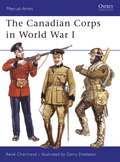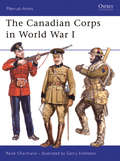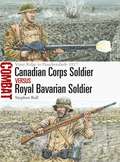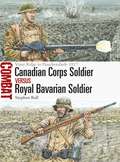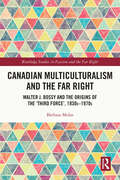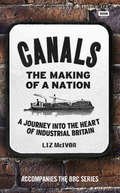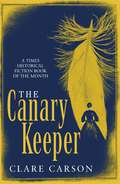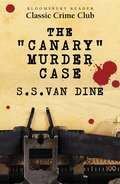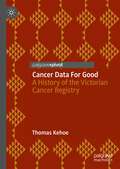- Table View
- List View
Canada: A Very Short Introduction (Very Short Introductions)
by Donald WrightCanada is not one nation, but three: English Canada, Quebec, and First Nations. Yet as a country Canada is very successful, in part because it maintains national diversity through bilingualism, multiculturalism, and federalism. Alongside this contemporary openness Canada also has its own history to contend with; with a legacy of broken treaties and residential schools for its Indigenous peoples, making reconciliation between Canada and First Nations an ongoing journey, not a destination. Drawing on history, politics, and literature, this Very Short Introduction starts at the end of the last ice age, when the melting of the ice sheets opened the northern half of North America to Indigenous peoples, and covers up to today's anthropogenic climate change, and Canada's climate politics. Donald Wright emphasizes Canada's complexity and diversity as well as its different identities and its commitment to rights, and explores its historical relationship to Great Britain, and its ongoing relationship with the United States. Finally, he examines Canada's northern realities and its northern identities. ABOUT THE SERIES: The Very Short Introductions series from Oxford University Press contains hundreds of titles in almost every subject area. These pocket-sized books are the perfect way to get ahead in a new subject quickly. Our expert authors combine facts, analysis, perspective, new ideas, and enthusiasm to make interesting and challenging topics highly readable.
Canada: A Very Short Introduction (Very Short Introductions)
by Donald WrightCanada is not one nation, but three: English Canada, Quebec, and First Nations. Yet as a country Canada is very successful, in part because it maintains national diversity through bilingualism, multiculturalism, and federalism. Alongside this contemporary openness Canada also has its own history to contend with; with a legacy of broken treaties and residential schools for its Indigenous peoples, making reconciliation between Canada and First Nations an ongoing journey, not a destination. Drawing on history, politics, and literature, this Very Short Introduction starts at the end of the last ice age, when the melting of the ice sheets opened the northern half of North America to Indigenous peoples, and covers up to today's anthropogenic climate change, and Canada's climate politics. Donald Wright emphasizes Canada's complexity and diversity as well as its different identities and its commitment to rights, and explores its historical relationship to Great Britain, and its ongoing relationship with the United States. Finally, he examines Canada's northern realities and its northern identities. ABOUT THE SERIES: The Very Short Introductions series from Oxford University Press contains hundreds of titles in almost every subject area. These pocket-sized books are the perfect way to get ahead in a new subject quickly. Our expert authors combine facts, analysis, perspective, new ideas, and enthusiasm to make interesting and challenging topics highly readable.
Canada's National Policy, 1883-1900 (PDF)
by Robert Craig BrownDisputes over fishing rights in the North Atlantic Ocean, sealing rights in the Behring Sea and on the Pribilof Islands, reciprocal trade relations, and the settlement of the Alaska Boundary are considered in relation to the underlying problem of competition between American and Canadian economic nationalism.Originally published in 1964.The Princeton Legacy Library uses the latest print-on-demand technology to again make available previously out-of-print books from the distinguished backlist of Princeton University Press. These editions preserve the original texts of these important books while presenting them in durable paperback and hardcover editions. The goal of the Princeton Legacy Library is to vastly increase access to the rich scholarly heritage found in the thousands of books published by Princeton University Press since its founding in 1905.
The Canadian Corps in World War I (Men-at-Arms)
by Gerry Embleton René ChartrandThis book describes the organization, lists the units and illustrates the uniforms and equipment of the four Canadian divisions which earned an elite reputation on the Western Front in 1915-18. Canada's 600,000 troops of whom more than 66,000 died and nearly 150,000 were wounded represented an extraordinary contribution to the British Empire's struggle. On grim battlefields from the Ypres Salient to the Somme, and from their stunning victory at Vimy Ridge to the final triumphant 'Hundred Days' advance of autumn 1918, Canada's soldiers proved themselves to be a remarkable army in their own right, founding a national tradition.
The Canadian Corps in World War I (Men-at-Arms)
by Gerry Embleton René ChartrandThis book describes the organization, lists the units and illustrates the uniforms and equipment of the four Canadian divisions which earned an elite reputation on the Western Front in 1915-18. Canada's 600,000 troops of whom more than 66,000 died and nearly 150,000 were wounded represented an extraordinary contribution to the British Empire's struggle. On grim battlefields from the Ypres Salient to the Somme, and from their stunning victory at Vimy Ridge to the final triumphant 'Hundred Days' advance of autumn 1918, Canada's soldiers proved themselves to be a remarkable army in their own right, founding a national tradition.
Canadian Corps Soldier vs Royal Bavarian Soldier: Vimy Ridge to Passchendaele 1917 (Combat)
by Adam Hook Stephen BullIn 1917 the soldiers of the Canadian Corps would prove themselves the equal of any fighting on the Western Front, while on the other side of the wire, the men of the Royal Bavarian Army won a distinguished reputation in combat. Employing the latest weapons and pioneering tactics, these two forces would clash in three notable encounters: the Canadian storming of Vimy Ridge, the back-and-forth engagement at Fresnoy and at the sodden, bloody battle of Passchendaele. Featuring carefully chosen archive photographs and specially commissioned artwork, this study assesses these three hard-fought battles in 1917 on the Western Front, and offers a new take on the evolving nature of infantry combat in World War I.
Canadian Corps Soldier vs Royal Bavarian Soldier: Vimy Ridge to Passchendaele 1917 (Combat)
by Adam Hook Stephen BullIn 1917 the soldiers of the Canadian Corps would prove themselves the equal of any fighting on the Western Front, while on the other side of the wire, the men of the Royal Bavarian Army won a distinguished reputation in combat. Employing the latest weapons and pioneering tactics, these two forces would clash in three notable encounters: the Canadian storming of Vimy Ridge, the back-and-forth engagement at Fresnoy and at the sodden, bloody battle of Passchendaele. Featuring carefully chosen archive photographs and specially commissioned artwork, this study assesses these three hard-fought battles in 1917 on the Western Front, and offers a new take on the evolving nature of infantry combat in World War I.
Canadian Historical Writing: Reading the Remains
by R. HulanCanadian Historical Writing presents an archaeology of contemporary Canadian historical writing within the theory and practice of historiography. Drawing on international debates within the fields of literary studies and history, the book focuses on the roles played by time, evidence, and interpretation in defining the historical.
Canadian History for Dummies
by Will FergusonA wild ride through Canadian history, fully revised and updated! This new edition of Canadian History For Dummies takes readers on a thrilling ride through Canadian history, from indigenous native cultures and early French and British settlements through Paul Martin's shaky minority government. This timely update features all the latest, up-to-the-minute findings in historical and archeological research. In his trademark irreverent style, Will Ferguson celebrates Canada's double-gold in hockey at the 2002 Olympics, investigates Jean Chrétien's decision not to participate in the war in Iraq, and dissects the recent sponsorship scandal.
Canadian History for Dummies
by Will FergusonA wild ride through Canadian history, fully revised and updated! This new edition of Canadian History For Dummies takes readers on a thrilling ride through Canadian history, from indigenous native cultures and early French and British settlements through Paul Martin's shaky minority government. This timely update features all the latest, up-to-the-minute findings in historical and archeological research. In his trademark irreverent style, Will Ferguson celebrates Canada's double-gold in hockey at the 2002 Olympics, investigates Jean Chrétien's decision not to participate in the war in Iraq, and dissects the recent sponsorship scandal.
Canadian Multiculturalism and the Far Right: Walter J. Bossy and the Origins of the ‘Third Force’, 1930s–1970s (Routledge Studies in Fascism and the Far Right)
by Bàrbara MolasCanadian Multiculturalism and the Far Right examines a neglected aspect of the history of 20th century Canadian multiculturalism and the far right to illuminate the ideological foundations of the concept of ‘third force’. Focusing on the particular thought of ultra-conservative Ukrainian Canadian Walter J. Bossy during his time in Montreal (1931–1970s), this book demonstrates that the idea that Canada was composed of three equally important groups emerged from a context defined by reactionary ideas on ethnic diversity and integration. Two broad questions shape this research: first, what the meaning originally attached to the idea of a ‘third force’ was, and what the intentions behind the conceptualization of a trichotomic Canada were; and second, whether Bossy’s understanding of the ‘third force’ precedes, or is related in any way to, postwar debates on liberal multiculturalism at the core of which was the existence of a ‘third force’. This book will be of interest to students and researchers of multiculturalism, radical-right ideology and the far right, and Canadian history and politics.
Canadian Multiculturalism and the Far Right: Walter J. Bossy and the Origins of the ‘Third Force’, 1930s–1970s (Routledge Studies in Fascism and the Far Right)
by Bàrbara MolasCanadian Multiculturalism and the Far Right examines a neglected aspect of the history of 20th century Canadian multiculturalism and the far right to illuminate the ideological foundations of the concept of ‘third force’. Focusing on the particular thought of ultra-conservative Ukrainian Canadian Walter J. Bossy during his time in Montreal (1931–1970s), this book demonstrates that the idea that Canada was composed of three equally important groups emerged from a context defined by reactionary ideas on ethnic diversity and integration. Two broad questions shape this research: first, what the meaning originally attached to the idea of a ‘third force’ was, and what the intentions behind the conceptualization of a trichotomic Canada were; and second, whether Bossy’s understanding of the ‘third force’ precedes, or is related in any way to, postwar debates on liberal multiculturalism at the core of which was the existence of a ‘third force’. This book will be of interest to students and researchers of multiculturalism, radical-right ideology and the far right, and Canadian history and politics.
Canadian Pacific Ships: The History of a Company and its Ships
by Ian CollardIn 1873 a company was formed to construct the first railway across Canada. It soon branched out into shipping, chartering ships from the Cunard Line for service between Vancouver, Yokohama, Shanghai and Hong Kong. In 1889 Canadian Pacific would be awarded the mail contract for the service across the Pacific and, by 1903, they would purchase Elder Dempster & Company and begin sailing from Liverpool to Quebec and Montreal.They obtained control of the Atlantic, rail and Pacific routes, and later interest in the Canadian–Australasian Line, becoming ‘the world’s greatest transportation system’, bridging two oceans and linking four continents. Canada’s largest operator of Atlantic and Pacific steamships until after the Second World War, CP Ships boasted such names as Empress of Britain, Empress of Ireland and Empress of Canada. This new history of the shipping side of Canadian Pacific includes a wealth of illustrations and a detailed fleet list that will enthral maritime enthusiasts.
Canadian Policy Debates and Case Studies in Honour of David Laidler
by Robert LeesonThis volume brings together some of the world's leading economists, to focus primarily on Canadian policy issues and case study debates in honour of David Laidler. Commemorating his success and active participation in the research and analysis of monetary policy.
Canal 250: The Story of Britain's Canals
by Anthony BurtonWhen a young English nobleman was thwarted in love he abandoned the court, retired to his estate near Manchester and built a canal to serve his coalmines. The Bridgewater Canal was the sensation of the age and led others to follow the example of the enterprising Duke of Bridgewater. From his starting point in 1760, over the next half-century Britain was covered by a network of waterways that became the lifeblood of the Industrial Revolution. This is the story of 250 years of history on those canals, and of the people who made and used them. The book tells of the great engineers, such as Telford, Brindley and Jessop and of the industrialists, such as Wedgwood and Arkwright who promoted the canals they built. It also tells the story of the anonymous navvies who dug the canals, the men and women who ran the boats and the workers who kept the canals running. Covering the entire history of the canal network (from the glorious early days, through the years of decline caused by rail and then road competition, up to the subsequent revival of the canals as leisure routes), this wonderfully illustrated book is a must-have for all canal enthusiasts.
Canals: A Journey Into The Heart Of Industrial Britain
by Liz McIvorCanals hold a unique place in British culture, with associations of lazy summer afternoons, journeying through lush green countryside. But as Liz McIvor explains in the book to accompany her BBC series, the story of our canals is also the story of how modern Britain was born. It was the canals that helped open up the trade of the Industrial Revolution, furthered the new science of geology, and even ushered in a new form of architecture. The legacy of our canals is all around us.In Canals: The Making of a Nation, McIvor takes us on a journey across the network of English canals to tell a deeper story of how our waterways changed our lives. It’s a very modern tale, full of high finance and greedy investors, cheap labour and the struggle for workers’ rights, and new frontiers in family and child welfare. It’s a unique and compelling exploration of Britain’s golden age.
Canals in Britain (Shire Library)
by Tony ConderIn the early years of the Industrial Revolution, canals formed the arteries of Britain. Most waterways were local concerns, carrying cargoes over short distances and fitted into regional groups with their own boat types linked to the major river estuaries. This new history of Britain's canals starts with the first Roman waterways, moving on to their golden age in the eighteenth and early nineteenth centuries, and ends with the present day, describing the rise and fall of canal building and use in the UK. It tells the story of the narrow boats and barges borne by the canals, and the boatmen who navigated them as well as the wider tale of waterway development through the progress of civil engineering. Replete with beautiful photographs, this a complete guide to some of the most accessible and beautiful pieces of Britain's heritage.
Canals In Britain (Shire Library)
by Tony ConderIn the early years of the Industrial Revolution, canals formed the arteries of Britain. Most waterways were local concerns, carrying cargoes over short distances and fitted into regional groups with their own boat types linked to the major river estuaries. This new history of Britain's canals starts with the first Roman waterways, moving on to their golden age in the eighteenth and early nineteenth centuries, and ends with the present day, describing the rise and fall of canal building and use in the UK. It tells the story of the narrow boats and barges borne by the canals, and the boatmen who navigated them as well as the wider tale of waterway development through the progress of civil engineering. Replete with beautiful photographs, this a complete guide to some of the most accessible and beautiful pieces of Britain's heritage.
The Canary Keeper
by Clare Carson'Historical fiction at its very best' ELLY GRIFFITHS. A Times Historical Fiction Book of the Month. They will see me hang for this. London, 1855. In the grey mist of the early morning a body is dumped on the shore of the Thames by a boatman in a metal canoe. Talk soon spreads of the killer and his striking accomplice: a young widow in mourning dress. Birdie Quinn's sleeplessness led her to the river that morning. She has always been wilful, haughty, different... but is she a murderess? To clear her name, she must retrace the dead man's footsteps to Orkney and the far north. A dangerous journey for a woman alone, but one she must make to save her life. This gripping, richly layered historical thriller is perfect for fans of The Familiars, The House Between Tides and The Confessions of Franny Langton. 'Historical fiction at its very best. Mesmerising setting, fantastic characters and a fascinating insight into a ruthless trade' ELLY GRIFFITHS. 'What a joy! Reads like a classic nineteenth-century mystery with a twist, richly dark and full of gaslit menace' LESLEY THOMSON. 'Unearths startling truths about death and corruption in the transatlantic fur trade' THE TIMES. 'A top quality piece of historical fiction' iSCOT MAGAZINE.
The Canary Murder Case: Large Print (Philo Vance Ser. #2)
by S.S. Van DineThe 'Canary' Murder Case First published in 1927, The Canary Murder Case is the second book in S. S. Van Dine's Philo Vance murder mystery series. It deals with the murder of a sexy nightclub singer known as "the Canary," and eventually, that of her boyfriend. The beautiful Margaret Odell, famous Broadway beauty and ex-Follies girl known as "The Canary", is found murdered in her apartment, and it's anyone's guess as to whodunit. She has a number of men in her life, ranging from high society to gangsters, and more than one man visited her apartment on the night she died. It is Philo Vance's characteristic erudition that leads him to a key clue that allows him to penetrate a very clever alibi and reveal the killer. As the narrator says: "The strangeness, the daring, the seeming impenetrability of the crime marked it as one of the most singular and astonishing cases in New York's police annals; and had it not been for Philo Vance's participation in its solution, I firmly believe it would have remained one of the great unsolved mysteries of this country."
The Cancel Culture Panic: How an American Obsession Went Global
by Adrian DaubFear of cancel culture has gripped the world, and it turns out to be an old fear in a new get-up. In this incisive new work, Adrian Daub analyzes the global spread of cancel culture discourse as a moral panic, showing that, though its object is fuzzy, talk of cancel culture in global media has become a preoccupation of an embattled liberalism. There are plenty of conservative voices who gin up worries about cancel culture to advance their agendas. But more remarkable perhaps is that it is centrist, even left-leaning, media that have taken up the rallying cry and really defined the outlines of what cancel culture is supposed to be. Media in Western Europe, South America, Russia, and Australia have devoted as much—in some cases more—attention to this supposedly American phenomenon than most US outlets. From French crusades against "le wokisme" via British fables of the "loony left" to a German obsession with campus anecdotes to a global revolt against "gender studies": countries the world over have developed culture war narratives in conflict with the US, and, above all, its universities—narratives that they themselves borrowed from the US. Who exactly is afraid of cancel culture? To trace how various global publics have been so quickly convinced that cancel culture exists and that it poses an existential problem, Daub compares the cancel culture panic to moral panics past, investigating the powerful hold that the idea of "being cancelled" has on readers around the world. A book for anyone wondering how institutions of higher learning in the US have become objects of immense interest and political lightning rods; not just for audiences and voters in the US, but worldwide.
The Cancel Culture Panic: How an American Obsession Went Global
by Adrian DaubFear of cancel culture has gripped the world, and it turns out to be an old fear in a new get-up. In this incisive new work, Adrian Daub analyzes the global spread of cancel culture discourse as a moral panic, showing that, though its object is fuzzy, talk of cancel culture in global media has become a preoccupation of an embattled liberalism. There are plenty of conservative voices who gin up worries about cancel culture to advance their agendas. But more remarkable perhaps is that it is centrist, even left-leaning, media that have taken up the rallying cry and really defined the outlines of what cancel culture is supposed to be. Media in Western Europe, South America, Russia, and Australia have devoted as much—in some cases more—attention to this supposedly American phenomenon than most US outlets. From French crusades against "le wokisme" via British fables of the "loony left" to a German obsession with campus anecdotes to a global revolt against "gender studies": countries the world over have developed culture war narratives in conflict with the US, and, above all, its universities—narratives that they themselves borrowed from the US. Who exactly is afraid of cancel culture? To trace how various global publics have been so quickly convinced that cancel culture exists and that it poses an existential problem, Daub compares the cancel culture panic to moral panics past, investigating the powerful hold that the idea of "being cancelled" has on readers around the world. A book for anyone wondering how institutions of higher learning in the US have become objects of immense interest and political lightning rods; not just for audiences and voters in the US, but worldwide.
Cancer Data For Good: A History of the Victorian Cancer Registry
by Thomas KehoeThis book examines the history of the Victorian Cancer Registry (VCR) in Australia from its establishment in the late 1930s through to the present day. It sheds new light on the history of medicine and the broader social and cultural histories affected by advances in cancer control science, providing a historical account of cancer registration that is empirically grounded in new archival and oral sources. It addresses the obstacles that proponents of cancer registration faced, how governments came to support permanent registries, and the subsequent contributions of the VCR and other registries to cancer research. In charting this history, the book discusses some of the political, social, and cultural implications of registry-driven science, and the links between developments in scientific knowledge and campaigning for policy changes around cancer.
Cancer Drug Discovery: Science and History
by Kyu-Won Kim Jae Kyung Roh Hee-Jun Wee Chan KimThe reader will discover a comprehensive and multifaceted overview of the history of the development of anticancer drugs deeply influenced by the cell concept of cancer and future directions for the development of new anticancer drugs. First, this book documents the scientific progress in biological science over the last 70 years and the influence this progress had in cancer research. Summaries and charts of important discoveries complete this overview. Furthermore, this book outlines the process of anticancer drug development with a focus on the characteristic drug groups of each era, related to advancements of chemistry and biological sciences. This book also provides brief mechanism of action of drugs, illustrated by comprehensive timelines and conceptual cartoons. This book finally sums up the limitations of the current anticancer drug development and seeks new directions for anticancer drug discovery, considering under the systemic view of cancer.


